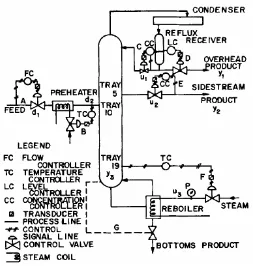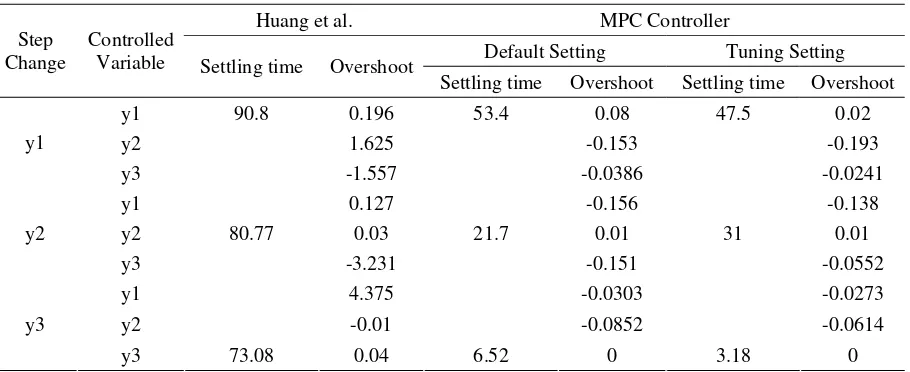APPLICATION OF MODEL PREDICTIVE CONTROL (MPC)
TUNING STRATEGY IN MULTIVARIABLE CONTROL OF
DISTILLATION COLUMN
A. Ahmad
1)and A. Wahid
2)Abstract
A model predictive control strategy is proposed for multivariable nonlinear control problem in a distillation column. The aim is to provide a solution to nonlinear control problem that is favorable in terms of industrial implementation. The scheme utilizes multiple linear models to cover wider range of operating conditions. Depending on the operating conditions, suitable model is used in control computations. Servo and regulatory controls of the system are examined. Comparisons are made to conventional controllers. The results confirmed the potentials of the proposed strategy.
Keywords : Tuning, model predictive control, multivariable, nonlinear control, chemical process
Introduction
Predictive control is now one of the most widely used advanced control methods in industry, especially in the control of processes that are constrained, multivariable and uncertain. A large number of implementation algorithms, including industrial predictive control applications (Qin and Badgwell, 2003) have appeared in the literature.
The cornerstone of MPC is the model (Clarke, 1996). It cause MPC is called MBPC (model-based predictive control). MPC uses models in 2 ways: using a reliable model to predict effect of past control moves on P (prediction horizon) future outputs, assuming no future moves, and using the same model to compute the optimal M (control) horizon moves.
Dynamic matrix control (DMC) (Cutler and Ramaker, 1980) is the most popular MPC algorithm used in chemical process industry today. Over the past decade, DMC has been implemented on a wide range of process applications. A major part of DMC’s appeal in industry stems from the use of a linear finite step response model of the process and a simple quadratic performance objective function. The objective function is minimized over a prediction horizon to compute the optimal controller output moves as a least-squares problem.
Tuning a controller is a direct way to reach its optimum performance. Tuning conventional controllers (P, PI, and PID) is related to obtain an optimum setting of controller parameters (controller gain Kc, integral time Ti, and derivative time Td).
Ziegler-Nichols, Lopez, Ciancone, etc. (Marlin, 2000) are some examples of single-loop tuning in P, PI, and PID controllers. Huang, et al. (2003) has proposed a
direct method for multi-loop (multivariable) PI/PID controller design based on FOPDT/SOPDT model of each loop.
An MPC controller has certain parameters setting to achieve its optimum performance. Those parameters are sampling time (T), prediction horizon (P), model horizon (N), control horizon (M), controlled variable weights ( ), and move
suppression coefficients ( ). During the time, trial-and-error efforts have been done to find out this goal until Shridhar and Cooper (Dougherty and Cooper, 2003) proposed a tuning strategy for unconstraint SISO and multivariable MPC. Dougherty and Cooper (2003) proposed a non-adaptive DMC tuning strategy (see Table 1) based on all of FOPDT models in systems.
OLMR Distillation Column
Consider OLMR (Ogunnaike, Lemaire, Morari, and Ray) distillation column (Ogunnaike, et al, 1983) as shown by Figure 1. The distillation column studied was a 19 plate having variable feed and side stream draw-off locations, with the binary ethanol-water system.
Although this multivariable control strategy may be implemented for either time domain or Laplace transform models, here we shall outline the essential features using a Laplace domain model. For multivariable systems such as distillation columns having multiple delays, a commonly employed linear model takes the form:
(1)
Table 1. Non-adaptive DMC tuning strategy
where y is a vector of outputs, u a vector of controls, and d a vector of disturbance variables. The outputs are yl = overhead ethanol mole fraction, y2 = side stream
ethanol mole fraction composition), and y3 = tray #19 temperature (oC) (corresponding to bottoms composition). The inputs are u1= reflux flow rate, gpm (m3/s), u2= side stream product flow rate, gpm (m3/s), and u3= reboiler stream pressure, psig (kPa); d1= feed flow rate, gpm (m3/s) and d2= feed temperature, oC.
The column model takes the Eq.1 form. The transfer functions of manipulated variable ( ) and
disturbance variable ( ) are shown in Table 2 (time unit is minutes).
(s)
G
p(s)
G
dSeveral methods to get the optimum performance of the plant have been implemented. Ogunnaike et al. (1983) have implemented PI controller with delay compensator to improve the control performance of PI controller without delay. Luyben, et al (1988) have developed the direct method of PID controller called BLT-1 based on Ziegler-Nichols method. Based on Luyben’s BLT-1 controller, the new methods were called BLT-2, BLT-3, and BLT-4. The methods have proved their ability to reach a better performance than the previous method. Even, BLT-4 was better than DMC controller. Based on an effective open-loop (EOP) model, Huang et al. (2003) have improved BLTs methods especially in 2x2 processes, but in the 3x3 process the optimum performance is 56% for Huang et al. method and 44% for BLT-4. In the 4x4 process, Huang et al. is better than BLT, while Lee et al. method is worse than BLT. Huang et al. has 69% of the optimum results while Lee et al. has 31%.
Although BLT was better than DMC (Luyben, et al, 1988), Dougherty and Cooper (2003) have proved that the applications of the non-adaptive DMC tuning strategy in the three 2x2 processes (general transfer function, multi-tank, and distillation column) have a satisfactory performance. So, we will implement this strategy to improve the control performance of OLMR distillation column that has 3x3 matrixes of input and output variables.
Results and Discussions
As shown in Table 1, the tuning strategy uses FOPDT (first-order plus dead-time) model to calculate Ts, P, M, , and . Because of OR (3x3) model has one SOPDT (second-order plus dead-time), this transfer function has to be changed into FOPDT. By using PRC (process reaction curve) from step change testing of the SOPDT and applying a method developed by Smith (Marlin, 2000), the FOPDT is obtained (K
2 2 However, this approximation is only to calculate the MPC tuning parameters, not as a plant. The plant to be simulated is the original model. The calculation produces Ts = 0.71, P = 91, M = 30, = 1, and =433,520. MPC TOOLS of MATLAB® was used to simulate the plant (OLMR 3x3 process). In the MPC setting, three parameters of Ts, P, and M are used, while the others used the default setting.
2
s
γ
2s
Table 2. Transfer function of manipulated variable (
G
p(s)
) and disturbance variable (G
d(s)
)Figure 2 shows IAE of multi-loop control for OMLR (3x3) process based on PID controller performance using BLT-4 and the first Huang et al.’s model. The control performance of y1 and y2 show the satisfactory results, except the y2 performance when y3 changed. But, all y3 performances are poor compared by BLT-4. From nine observed IAEs, five minimum IAEs are for Huang et al. and four minimum IAEs are for BLT-4. This result shows that Huang et al. method of PID controller tuning does not give satisfactory result. Application of MPC controller with tuning its parameters in OMLR 3x3 distillation column model will be evaluated.
Figure 2. IAE values (in parentheses) of multi-loop control for OR (3x3) process
Figure 3 shows responses of OLMR 3x3 process using MPC with tuning setting. The control performances of this process, compared to application of MPC controller without tuning and application of Huang et al. method are shown in Table 3. Almost performances by MPC tuning setting are better than those the default setting and Huang et al. Only two points where the default setting is better than the tuning setting, they are overshoot of y2 in y1’s step change,
Table 4. Performance of MPC controller of OR (3x3 process) model
Huang et al. MPC Controller
Default Setting Tuning Setting Step
Change
Controlled
Variable Settling time Overshoot
Settling time Overshoot Settling time Overshoot y1 90.8 0.196 53.4 0.08 47.5 0.02
y2 1.625 -0.153 -0.193
y1
y3 -1.557 -0.0386 -0.0241
y1 0.127 -0.156 -0.138
y2 80.77 0.03 21.7 0.01 31 0.01 y2
y3 -3.231 -0.151 -0.0552
y1 4.375 -0.0303 -0.0273
y2 -0.01 -0.0852 -0.0614
y3
y3 73.08 0.04 6.52 0 3.18 0
Conclussions
MPC controller offers better control performances than PI/PID controller, especially in multivariable processes. Application of MPC controller using tuning strategy in the OLMR (3x3) distillation column model produces a fantastic performance. However, there is still a chance to continue the improvement of MPC controller to solve two bad results in the control performance of OLMR 3x3 process.
References
C. R. Cutler and D. L. Ramaker, (1980), “Dynamic matrix control—a computer control algorithm”.
Proceedings of the JACC 1980. San Francisco.
D.W. Clarke, (1996) “Adaptive Predictive Control”. A
Rev. Control. Vol. 20, pp. 83-94, 1996
Danielle Dougherty and Doug Cooper, (2003), “A Practical Multiple Model Adaptive Strategy for Multivariable Model Predictive Control”, Control
Engineering Practice. (11): 649 – 664, 2003.
Huang et. al. (2003), “A direct method for multi-loop PI/PID controller design”. Journal of Process
Control (13): 769–786.
Ogunnaike, et al., (1983), “Advanced Multivariable Control of a Pilot-Plant Distillation Column”. AlChE
Journal (29/ 4): 632-640.
S.J. Qin and T.A. Badgwell, (2003). “A survey of industrial model predictive control technology”.
Control Engineering Practice. (11): 733 – 764
T. Marlin, (2000), “Process Control: Designing Processes and Control Systems for Dynamic
Performance”, 2nd Edition,McGraw-Hill, New
York.
Thomas J. Monica, Cheng-Ching Yu, and William L. Luyben (1988), “Improved Multiloop Single-Input/Single-Output (SISO) Controllers for Multivariable Processes”. Reprinted from I&EC


